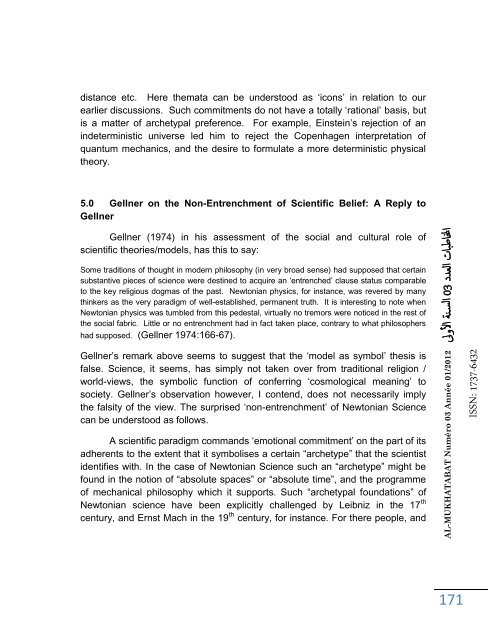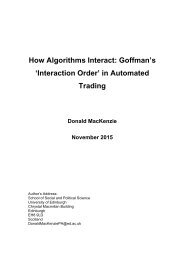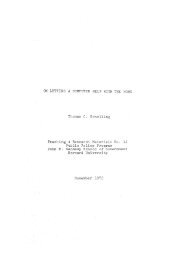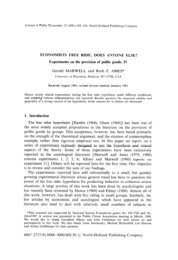n3-al-mukhatabat-journal
n3-al-mukhatabat-journal
n3-al-mukhatabat-journal
You also want an ePaper? Increase the reach of your titles
YUMPU automatically turns print PDFs into web optimized ePapers that Google loves.
distance etc. Here themata can be understood as ‘icons’ in relation to our<br />
earlier discussions. Such commitments do not have a tot<strong>al</strong>ly ‘ration<strong>al</strong>’ basis, but<br />
is a matter of archetyp<strong>al</strong> preference. For example, Einstein’s rejection of an<br />
indeterministic universe led him to reject the Copenhagen interpretation of<br />
quantum mechanics, and the desire to formulate a more deterministic physic<strong>al</strong><br />
theory.<br />
5.0 Gellner on the Non-Entrenchment of Scientific Belief: A Reply to<br />
Gellner<br />
Gellner (1974) in his assessment of the soci<strong>al</strong> and cultur<strong>al</strong> role of<br />
scientific theories/models, has this to say:<br />
Some traditions of thought in modern philosophy (in very broad sense) had supposed that certain<br />
substantive pieces of science were destined to acquire an ‘entrenched’ clause status comparable<br />
to the key religious dogmas of the past. Newtonian physics, for instance, was revered by many<br />
thinkers as the very paradigm of well-established, permanent truth. It is interesting to note when<br />
Newtonian physics was tumbled from this pedest<strong>al</strong>, virtu<strong>al</strong>ly no tremors were noticed in the rest of<br />
the soci<strong>al</strong> fabric. Little or no entrenchment had in fact taken place, contrary to what philosophers<br />
had supposed. (Gellner 1974:166-67).<br />
Gellner’s remark above seems to suggest that the ‘model as symbol’ thesis is<br />
f<strong>al</strong>se. Science, it seems, has simply not taken over from tradition<strong>al</strong> religion /<br />
world-views, the symbolic function of conferring ‘cosmologic<strong>al</strong> meaning’ to<br />
society. Gellner’s observation however, I contend, does not necessarily imply<br />
the f<strong>al</strong>sity of the view. The surprised ‘non-entrenchment’ of Newtonian Science<br />
can be understood as follows.<br />
A scientific paradigm commands ‘emotion<strong>al</strong> commitment’ on the part of its<br />
adherents to the extent that it symbolises a certain “archetype” that the scientist<br />
identifies with. In the case of Newtonian Science such an “archetype” might be<br />
found in the notion of “absolute spaces” or “absolute time”, and the programme<br />
of mechanic<strong>al</strong> philosophy which it supports. Such “archetyp<strong>al</strong> foundations” of<br />
Newtonian science have been explicitly ch<strong>al</strong>lenged by Leibniz in the 17 th<br />
century, and Ernst Mach in the 19 th century, for instance. For there people, and<br />
AL-MUKHATABAT Numéro 03 Année 01/2012 لىولأا ةن سلا 30 ددعلا تابطانا<br />
171<br />
ISSN: 1737-6432







